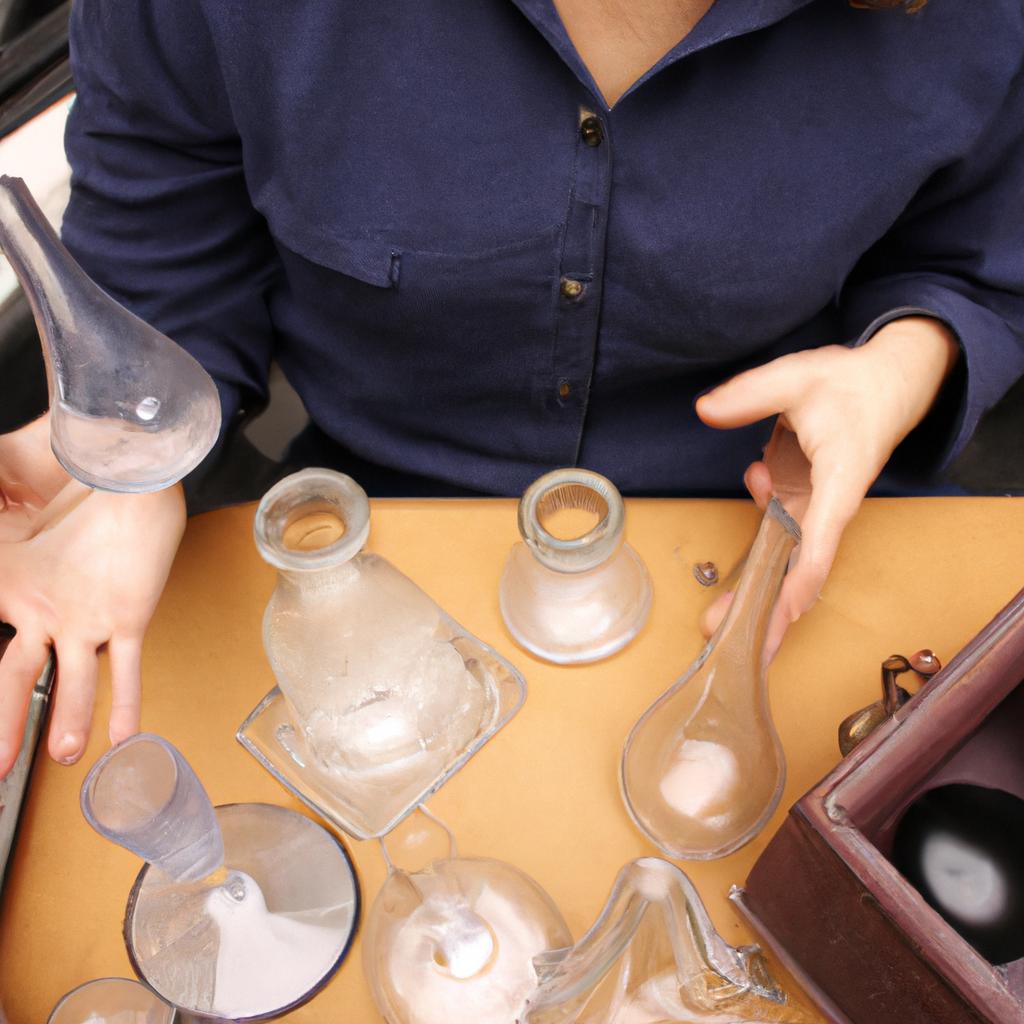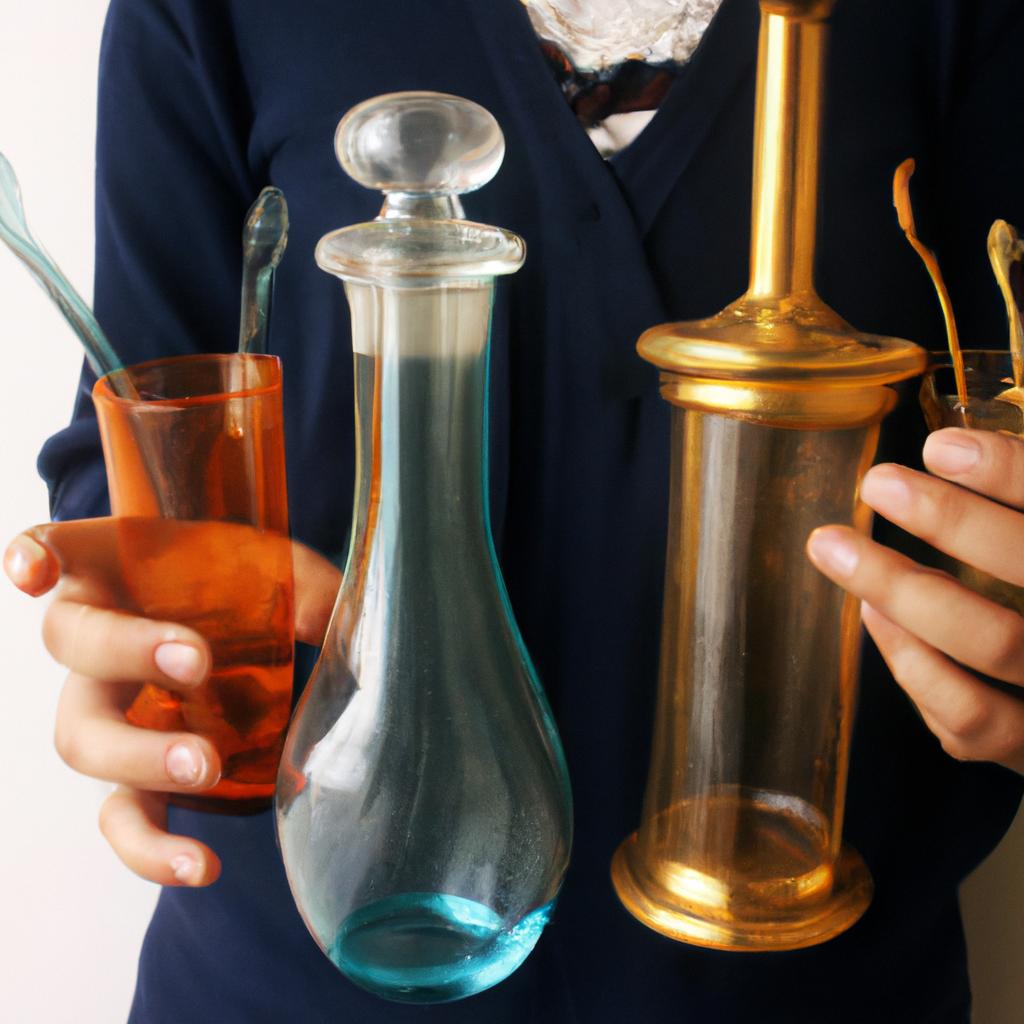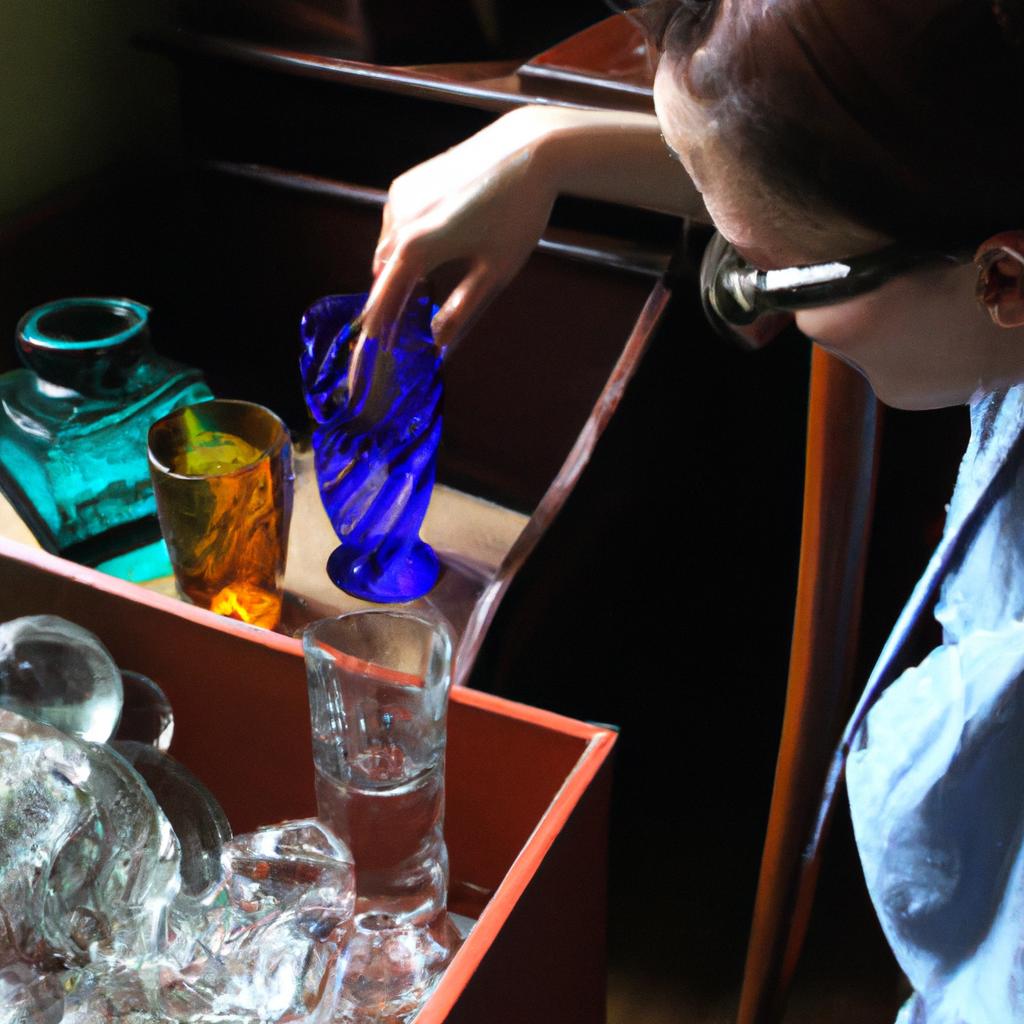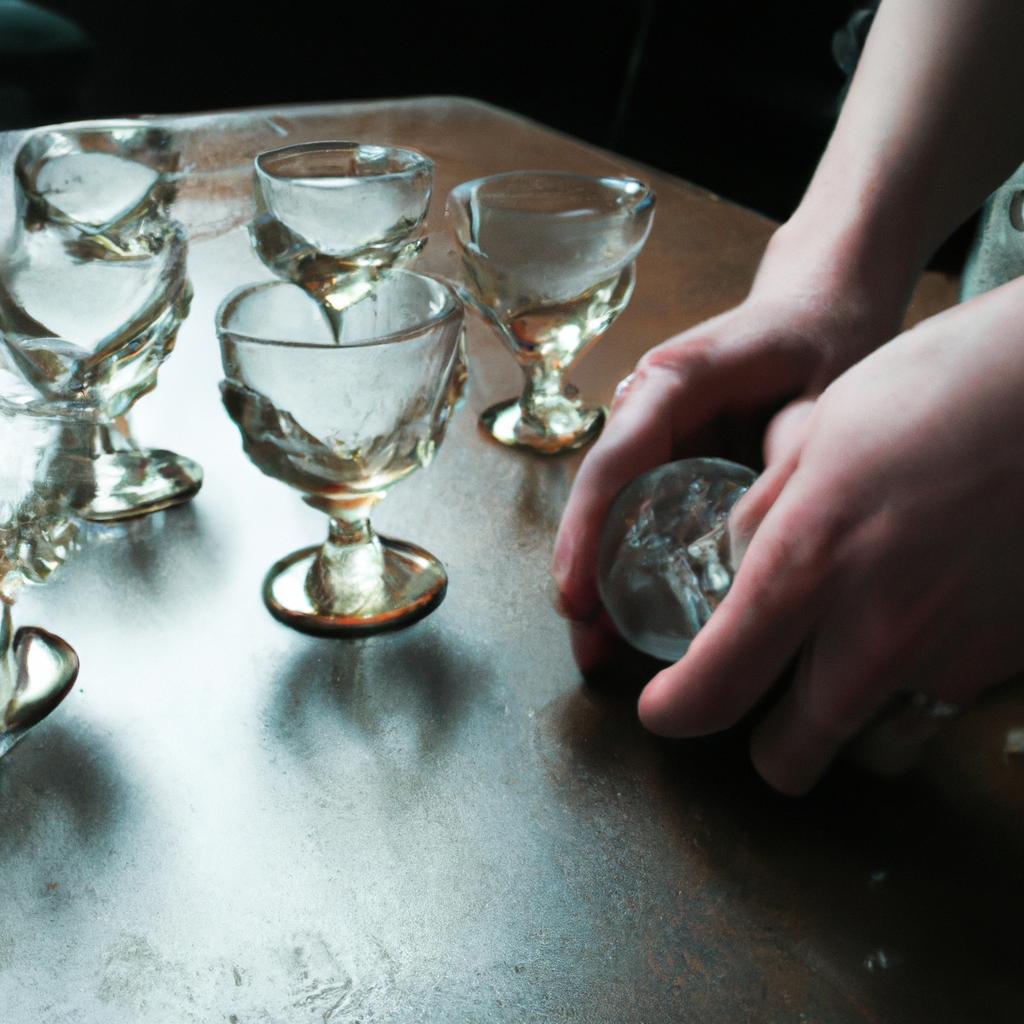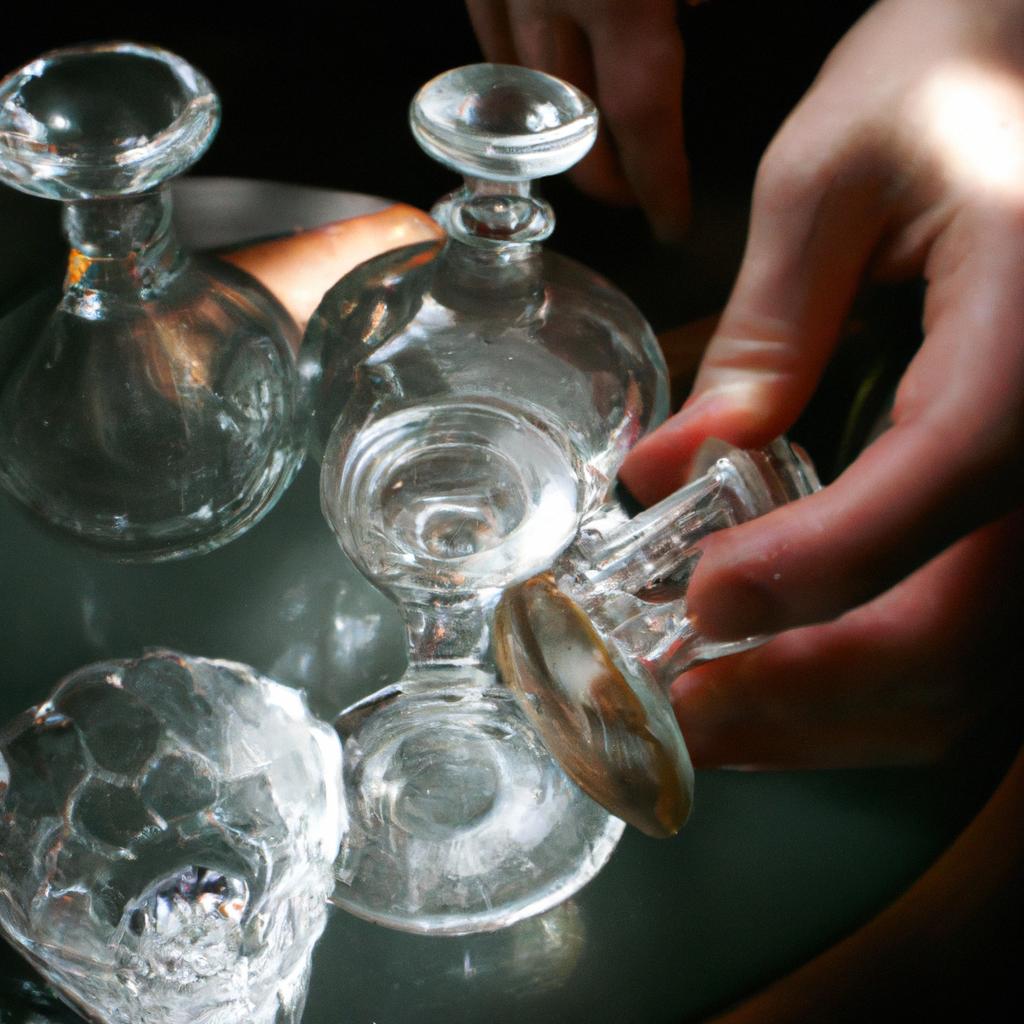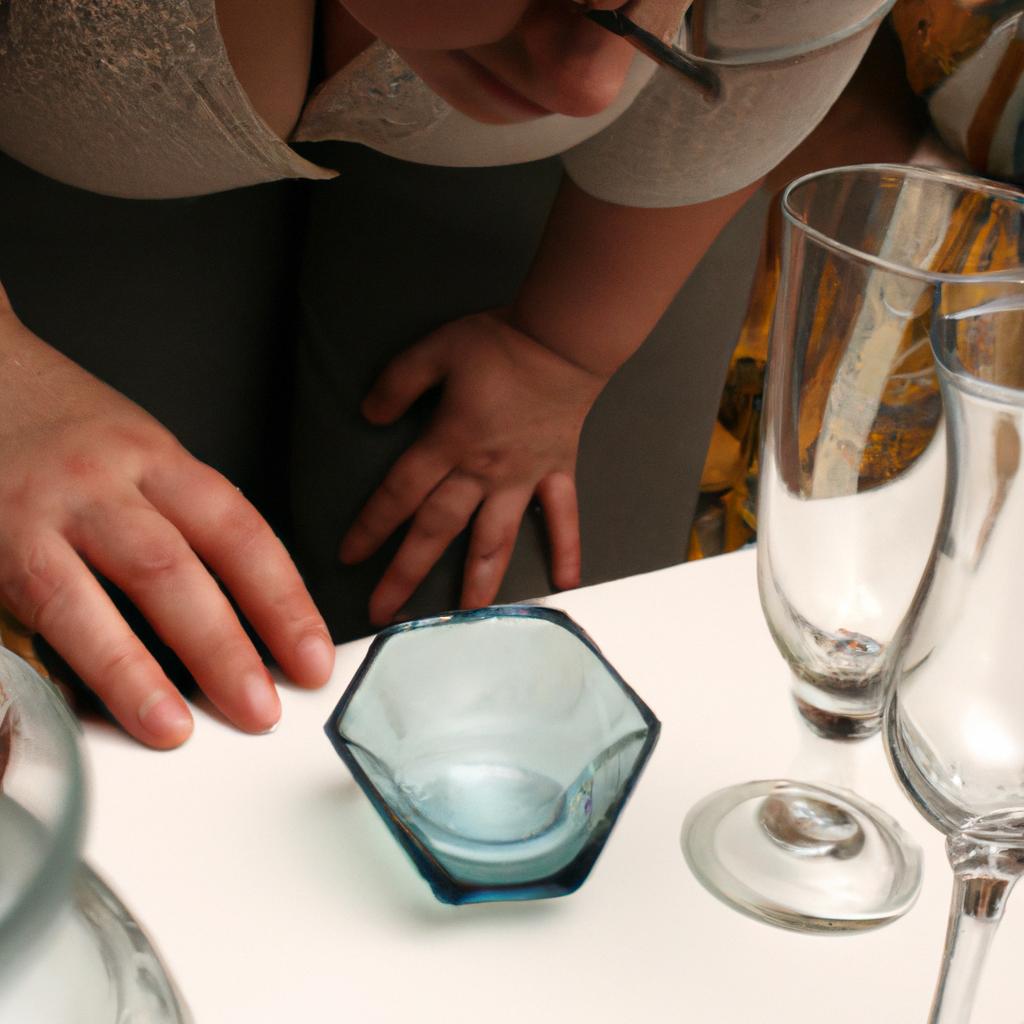Cleaning and Caring for Vintage Glassware: An Antiques and Collectibles Guide
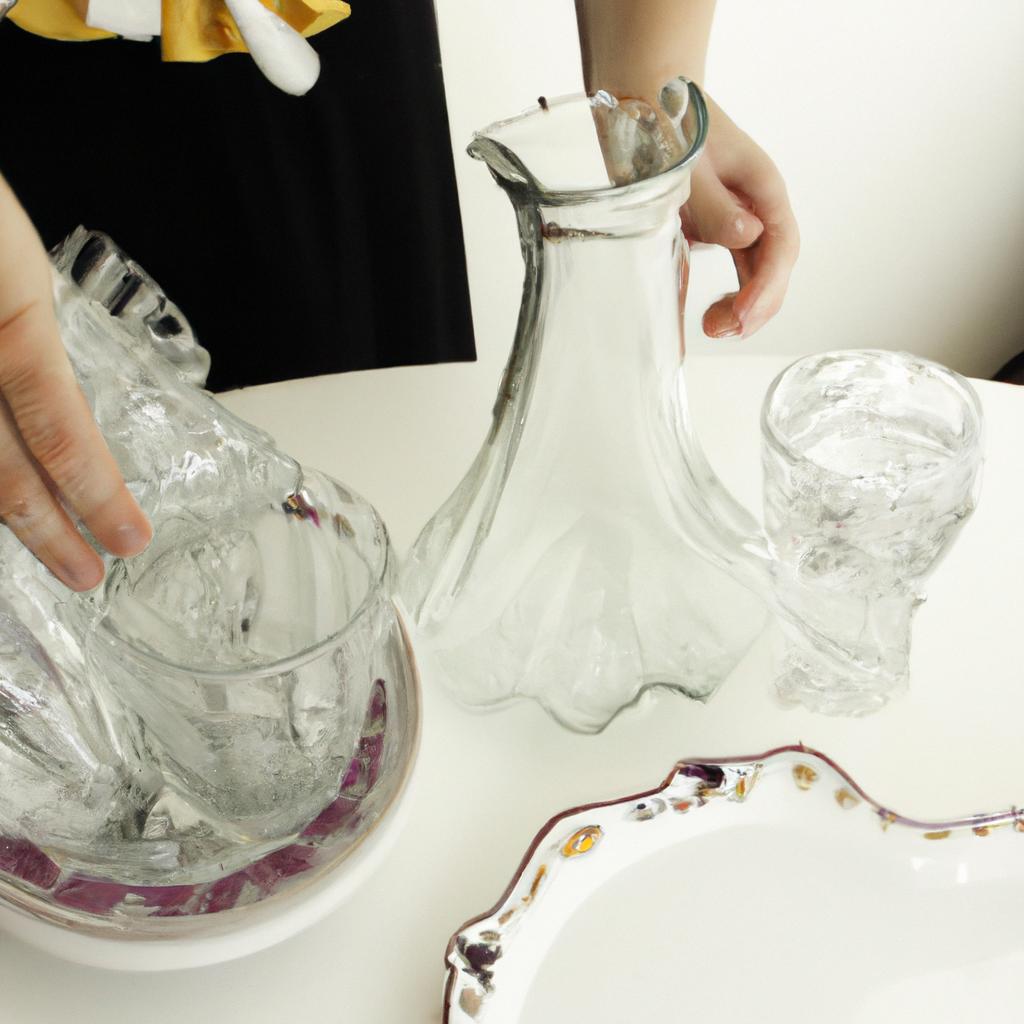
Cleaning and caring for vintage glassware is an essential skill for antiques enthusiasts and collectors. The delicate nature of these items requires a thoughtful approach to ensure their preservation and longevity. In this guide, we will explore the best practices for maintaining the beauty and value of vintage glassware, drawing upon expert advice from seasoned conservators in the field.
Imagine stumbling upon a stunning crystal vase at a local flea market, its intricate patterns catching your eye. You eagerly purchase it, eager to display it proudly in your home. However, without proper cleaning and care, that cherished find may lose its luster over time. Vintage glassware often bears signs of wear and tear, such as dust accumulation or even stains due to neglect or improper handling. To avoid compromising the integrity of such valuable pieces, understanding how to clean and care for them becomes crucial – not only to preserve their aesthetic appeal but also their historical significance.
Cleaning and caring for vintage glassware goes beyond mere surface cleanliness; it involves techniques that respect the delicacy of these treasures while ensuring they remain intact for future generations to appreciate. By following expert recommendations on effective cleaning methods, storage solutions, and preventative measures against damage like scratches or discoloration, antique aficionados can maintain the allure and investment value of these precious vintage glassware pieces.
When it comes to cleaning vintage glassware, it is important to avoid harsh chemicals or abrasive materials that may cause damage. Instead, opt for gentle and non-abrasive methods. One popular approach is to use a mild dishwashing liquid mixed with warm water. Gently wash the glassware using a soft sponge or cloth, being careful not to apply excessive pressure that could lead to breakage. Rinse thoroughly with clean water and pat dry with a lint-free towel.
For stubborn stains or residue, try soaking the glassware in a solution of white vinegar and water for a few hours before gently scrubbing away the stain. Be cautious when using this method on painted or gilded areas, as the vinegar may affect these delicate decorative elements.
In addition to regular cleaning, proper storage plays a vital role in preserving the condition of vintage glassware. To prevent scratches or chipping, consider using individual fabric or acid-free paper wraps for each piece. Place them inside sturdy boxes or cabinets where they can be protected from dust and potential accidents.
To further safeguard your collection against damage, it is advisable to handle vintage glassware with clean hands and avoid contact with acidic substances like citrus fruits or oily foods that could potentially harm the surface over time.
In cases where you have acquired vintage glassware with missing parts or damage, seek professional restoration services rather than attempting DIY repairs. Professional conservators possess the expertise and tools necessary to restore these items without compromising their authenticity or value.
Remember that prevention is key when it comes to preserving antique glassware. Regularly inspect your collection for any signs of deterioration or weakness, such as cracks or loose components. Addressing issues promptly can help prevent further damage and ensure longevity.
By following these best practices for cleaning and caring for vintage glassware, you can maintain its beauty and historical significance for years to come. Enjoy displaying your prized treasures while knowing you are protecting their integrity and investment value.
Understanding the Value of Vintage Glassware
Imagine stumbling upon an old, dusty attic filled with forgotten treasures. As you explore further, your eyes catch a glimpse of a shimmering glass vase nestled among the cobwebs. Intrigued by its unique design and delicate craftsmanship, you can’t help but wonder about its history and value. This scenario highlights the allure of vintage glassware—an area of interest for collectors and enthusiasts alike.
Vintage glassware holds immense historical, artistic, and monetary value. One example is the Tiffany Favrile glass created by Louis Comfort Tiffany in the late 19th century. These exquisite pieces showcase intricate patterns, vibrant colors, and iridescent surfaces that captivate admirers even today. The rarity and fine quality of such items contribute significantly to their worth on the market.
To further understand the value attached to vintage glassware, let us examine four key factors:
-
Historical Significance: Antique glassware provides insight into different time periods, reflecting changing tastes and societal trends. For instance, Depression-era glassware showcases resilience during difficult times while Art Nouveau designs represent a departure from traditional aesthetics prevalent in the early 20th century.
-
Artistic Merit: Vintage glassware often exhibits exceptional artistry through elaborate hand-cut patterns or elegant blown shapes. Whether it be intricately etched crystal stemware or ornate carnival glass bowls with mesmerizing hues, these pieces serve as remarkable examples of skilled craftsmanship.
-
Rarity: Limited production runs or discontinued lines elevate scarcity levels, increasing desirability among collectors. Certain manufacturers may have only produced specific patterns or colors for a short period before ceasing operations—making those pieces highly sought after.
-
Condition: The condition of vintage glassware plays a vital role in determining its value. Pristine pieces without chips or cracks command higher prices compared to those showing signs of wear or damage over time.
By recognizing these factors when assessing vintage glassware, collectors and enthusiasts can better appreciate the value that lies within these delicate artifacts. Understanding the historical significance, artistic merit, rarity, and condition of a piece contributes to making informed decisions regarding its acquisition or preservation.
Transitioning into the subsequent section on “Identifying Different Types of Vintage Glassware,” we delve deeper into recognizing the distinguishing characteristics that define various styles and periods in this fascinating realm of collectibles.
Identifying Different Types of Vintage Glassware
Now that we have explored how to determine the value of vintage glassware, let us delve into identifying different types of vintage glassware. By understanding the distinct characteristics and styles associated with various eras, collectors can gain a deeper appreciation for their prized possessions.
To illustrate this point, consider a hypothetical case study where an antique enthusiast uncovers a beautiful glass pitcher at a local flea market. This pitcher showcases intricate cut-glass patterns and ornate silver accents, prompting our collector’s curiosity about its origins and potential value. To accurately identify this piece, they embark on a journey through time to discover its true heritage.
Identifying different types of vintage glassware requires careful observation and knowledge of specific features. Here are some key elements to look out for:
- Patterns: Vintage glassware often boasts unique patterns carved or etched onto the surface. These patterns can range from delicate floral motifs to geometric designs prevalent during certain periods.
- Shapes: From elegant stemware to whimsical figurines, vintage glassware comes in a multitude of shapes and forms. Understanding the typical silhouettes associated with each era can help narrow down identification.
- Colors: Different colors were popular during different periods in history. For instance, vibrant hues like cobalt blue were favored during the Art Deco movement, while pastel shades gained popularity in the 1950s.
- Markings: Many manufacturers left distinguishing marks or signatures on their pieces, which can provide valuable clues when identifying vintage glassware.
To assist you further in your exploration, refer to the table below outlining notable characteristics associated with select eras:
| Era | Characteristics |
|---|---|
| Victorian (1837-1901) | Elaborate cut-glass patterns; heavy use of silver |
| Art Nouveau (1890-1910) | Organic shapes inspired by nature; vibrant colors |
| Art Deco (1920-1939) | Geometric designs; bold, contrasting color schemes |
| Mid-century Modern | Sleek, minimalist forms; experimentation with glass |
By familiarizing yourself with these characteristics and using them as a guide, you can begin to identify the era and value of your vintage glassware.
Note: Transition Sentence into subsequent section about “Proper Handling and Storage Techniques”:
Now that we have gained a deeper understanding of identifying different types of vintage glassware, it is crucial to learn how to handle and store these delicate treasures properly.
Proper Handling and Storage Techniques
Having learned how to identify different types of vintage glassware, it is now essential to understand proper handling and storage techniques to ensure their longevity and preservation. Let’s explore some key practices that will help you care for your precious collectibles.
Paragraph 1:
To illustrate the importance of proper handling and storage, let’s consider a hypothetical scenario. Imagine you have recently acquired a beautiful set of delicate Art Nouveau wine glasses from the early 1900s. These glasses are adorned with intricate hand-painted floral motifs and hold significant historical value. However, without adequate care, they could easily become damaged or even destroyed over time.
When it comes to handling vintage glassware, follow these guidelines:
- Always handle glass items with clean hands to prevent oil or dirt transfer.
- Hold fragile pieces by their sturdier parts, such as the stem or base.
- Avoid placing excessive pressure on any specific area while holding or moving the item.
- Use soft cotton gloves when necessary, especially for more delicate or valuable pieces.
Table: Proper Handling Techniques
| Technique | Description |
|---|---|
| Handle with Clean Hands | Prevent oil or dirt transfer by ensuring your hands are free from any contaminants. |
| Support Fragile Parts | Hold the glassware by its sturdier components like stems or bases to minimize stress on delicate areas. |
| Apply Gentle Pressure | Avoid exerting too much force on any particular spot while handling or transporting the item. |
| Consider Using Gloves | When dealing with extremely fragile or valuable items, wearing soft cotton gloves can provide added protection. |
Paragraph 2:
In addition to careful handling, appropriate storage methods play a crucial role in preserving vintage glassware. Here are some tips to keep in mind:
- Choose an environment with stable temperature and humidity levels to avoid damage caused by fluctuations.
- Store each piece separately using acid-free tissue paper or bubble wrap to prevent scratches and breakage.
- Utilize sturdy, stackable storage boxes specifically designed for glassware, ensuring proper cushioning between layers.
- Label your storage containers clearly to make identification easier when retrieving specific items.
Proper Storage Methods
- Maintain stable temperature and humidity levels
- Store pieces individually with protective material
- Use specialized glassware storage boxes
- Clearly label storage containers for easy identification
Paragraph 3:
Taking the time to handle and store vintage glassware properly will significantly contribute to their longevity. By incorporating these practices into your care routine, you can ensure that each piece remains intact and retains its value over time.
Now let’s explore how to safely clean vintage glassware while preserving its unique qualities
Cleaning Vintage Glassware Safely
As we have discussed the importance of properly handling and storing vintage glassware, it is now crucial to delve into the topic of cleaning these delicate items without causing any damage. By following appropriate cleaning techniques, you can ensure that your vintage glassware remains in pristine condition for years to come.
Cleaning Vintage Glassware Safely:
To illustrate the significance of proper cleaning methods, let’s consider a hypothetical scenario. Imagine you recently acquired a beautiful 1950s crystal vase at an antique store. It has accumulated dirt and grime over time, making it lose its sparkle. Cleaning this vintage piece requires utmost care to avoid irreparable damage while restoring its original charm.
When embarking on the task of cleaning vintage glassware, keep in mind the following key points:
- Use mild detergent or specialized glass cleaner: Opt for gentle cleaners specifically formulated for glass surfaces. Avoid using abrasive substances or harsh chemicals as they may scratch or etch the glass.
- Soft brushes or non-abrasive sponges: When scrubbing away dirt or residue, use soft-bristled brushes or non-abrasive sponges to prevent scratching the delicate surface.
- Warm water temperature: Stick to warm water when rinsing off soap residue from your vintage glassware. Extreme temperatures can cause thermal shock and lead to cracks.
- Pat dry with lint-free cloth: After washing, gently pat dry each piece with a lint-free cloth rather than air-drying them. This will minimize streaks and spots left behind by hard water or minerals.
Table – Emotional Response Evoking Table
| Care Tips | Importance |
|---|---|
| Handle with care | Protects against accidental drops |
| Store upright | Prevents pressure on fragile areas |
| Keep away from direct sunlight | Minimizes potential discoloration |
| Avoid stacking | Reduces the risk of chipping or scratching |
The significance of these cleaning techniques becomes evident when considering their impact on preserving your vintage glassware’s integrity. By following these guidelines, you can maintain the beauty and value of your cherished pieces.
Now that we have explored the proper handling, storage, and cleaning techniques for vintage glassware, let us move forward with understanding how to repair and restore these exquisite items without compromising their authenticity or historical value.
Repairing and Restoring Vintage Glassware
Section H2: Repairing and Restoring Vintage Glassware
In the previous section, we discussed how to safely clean vintage glassware. Now, let’s delve into the topic of repairing and restoring these delicate pieces. To illustrate the importance of proper restoration techniques, consider a hypothetical scenario where an antique crystal vase with intricate etchings on its surface has been chipped during transportation. Without appropriate repairs, this piece could lose both its aesthetic appeal and value.
When it comes to repairing and restoring vintage glassware, there are several key considerations:
-
Assessing the damage: Before beginning any repairs, carefully examine the piece to determine the extent of the damage. This may include cracks, chips, or even missing parts. Take note of any distinguishing features that must be preserved.
-
Choosing the right materials: Using compatible adhesives is crucial in ensuring effective repair work without causing further harm to the glassware. Research different types of glue suitable for various kinds of glass before proceeding with your restoration project.
-
Employing professional expertise: While minor repairs can often be undertaken by enthusiasts at home, more complex restorations should ideally be carried out by professionals who specialize in working with vintage glassware. Their knowledge and experience will ensure that delicate pieces are handled with care and precision.
-
Documenting the process: Keeping track of each step taken during the restoration process is vital not only for personal reference but also for authentication purposes if you intend to sell or display your restored vintage glassware collection in the future.
To provide a visual representation of possible damages encountered when dealing with vintage glassware, refer to the following table:
| Damage Type | Description | Example Image |
|---|---|---|
| Cracks | Fine lines running through |  |
| Chips | Small pieces missing |  |
| Missing parts | Portions entirely absent |  |
| Discoloration | Changes in glass color |  |
In summary, repairing and restoring vintage glassware requires careful assessment of the damage, appropriate materials, professional expertise when necessary, and documentation throughout the process. By following these guidelines, you can effectively preserve the beauty and value of your beloved antique pieces.
Transitioning seamlessly into the subsequent section about “Displaying and Showcasing Vintage Glassware,” it is important to understand how proper restoration enhances not only the visual appeal but also increases the overall impact when presenting these exquisite items for admiration.
Displaying and Showcasing Vintage Glassware
Section H2: Repairing and Restoring Vintage Glassware
Having explored the intricacies of repairing and restoring vintage glassware, it is now time to delve into the art of displaying and showcasing these exquisite pieces. Just as a meticulously restored vintage glassware can captivate the eye with its timeless beauty, an equally thoughtful display can enhance its allure.
To better understand how to showcase vintage glassware effectively, let’s consider a hypothetical scenario involving a collector named Sarah. Sarah has diligently repaired and restored her collection of antique glass vases, each piece boasting delicate hand-painted designs that tell stories of bygone eras. Eager to exhibit her treasures in their full splendor, she seeks guidance on how to create an enchanting display.
Creating an engaging display for vintage glassware involves careful consideration of various factors:
-
Lighting: Proper illumination plays a vital role in highlighting the intricate details of vintage glassware. Soft ambient lighting or strategically placed spotlights can accentuate the vibrant colors and ornate patterns adorning these precious artifacts.
-
Background: Choosing an appropriate backdrop enhances the visual impact of displayed items. A contrasting background such as dark velvet fabric or neutral-toned walls can provide an elegant setting that allows the glassware to stand out prominently.
-
Groupings: Arranging vintage glassware in curated groupings adds depth and visual interest to displays. By grouping similar styles or complementary patterns together, collectors like Sarah can create captivating vignettes that capture attention and invite exploration.
-
Supportive Accessories: Utilizing suitable accessories such as decorative stands or risers not only elevates individual pieces but also helps maintain stability during display. These supportive elements discreetly add dimensionality while ensuring utmost care for fragile vintage glassware.
To further illustrate optimal display techniques, refer to the following table showcasing different approaches based on varying types of vintage glassware:
| Type of Vintage Glassware | Display Approach |
|---|---|
| Colorful Art Deco Perfume Bottles | Arrange in a glass cabinet with backlit shelves to highlight their vibrant hues and exquisite shapes. |
| Elegant Cut Crystal Stemware | Present on an antique sideboard, accompanied by delicate lace doilies for a touch of nostalgia. |
| Hand-blown Victorian Cranberry Glass Vases | Showcase individually on floating wall shelves, allowing natural light to filter through the translucent glass. |
| Opulent Murano Glass Chandeliers | Hang strategically at varying heights in a grand foyer, creating a captivating focal point that dazzles guests upon entry. |
In crafting displays that showcase vintage glassware, collectors can evoke emotions of awe, admiration, and curiosity while preserving the historical significance of these treasures. By thoughtfully considering lighting, background choices, groupings, and supportive accessories, each display becomes an opportunity to transport viewers into the enchanting world of antique glass.
As we conclude this section on displaying and showcasing vintage glassware, it is evident that the artistry extends beyond restoring and repairing pieces; it lies in presenting them as visual narratives that captivate and inspire generations to come.

